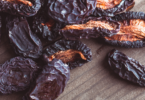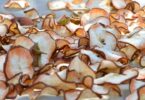Learn how to dry citrus peels!
Citrus peels are not only packed with flavor but also offer numerous health benefits. Drying citrus peels is an excellent way to preserve their aromatic qualities and unlock their potential in various culinary and wellness applications. In this article, we will explore the process of drying citrus peels and how you can use them to enhance your dishes and promote well-being.
Why Dry Citrus Peels?
Drying citrus peels offers several advantages over using fresh peels. By removing the moisture, you can concentrate the flavors and extend the shelf life of the peels. Additionally, dried citrus peels are more convenient to store and use throughout the year. They add a burst of citrusy aroma and taste to a wide range of recipes, including teas, desserts, marinades, and spice blends.
How to Dry Citrus Peels
Choosing the Right Citrus Fruit
Not all citrus fruits are created equal when it comes to drying peels. Oranges, lemons, limes, and grapefruits are the most commonly used fruits for this purpose. When selecting citrus fruits, opt for organic ones whenever possible to avoid exposure to pesticides. Choose fruits that are firm, aromatic, and free from blemishes.
Preparation
Before drying the citrus peels, it’s essential to wash them thoroughly to remove any dirt or wax.
Use a brush and warm water to scrub the peels gently. If you plan to use the fruit as well, juice or eat it, extract the peels carefully to avoid damaging the inner fruit.
Once the peels are separated, cut them into thin, uniform strips or small pieces, ensuring they are of similar size for even drying.
Oven Drying Citrus Peels
The oven-drying method is a convenient way to dry citrus peels if you don’t have access to direct sunlight.
- Preheat your oven to a low temperature, around 180°F (82°C).
- Spread the prepared citrus peels in a single layer on a baking sheet lined with parchment paper.
- Place the sheet in the oven and leave the door slightly ajar to allow moisture to escape.
Check the peels regularly and flip them to ensure even drying. It may take 2-3 hours for the peels to dry completely.
Sun Drying Citrus Peels
Sun drying is a traditional and cost-effective method to dry citrus peels.
- Choose a sunny and dry location, preferably with good airflow.
- Lay the citrus peels on a clean mesh or a drying rack. Protect them from dust and insects by covering them with a fine mesh or cheesecloth.
- Turn the peels occasionally to expose all sides to the sun.
Depending on the weather conditions, it can take several days to a couple of weeks for the peels to dry thoroughly.
Using a Dehydrator to Dry Citrus Peels
Using a dehydrator is another efficient way to dry citrus peels, especially if you have a large quantity to process.
- Follow the manufacturer’s instructions to set the temperature and time. Generally, a temperature between 100°F (38°C) and 140°F (60°C) is recommended for drying citrus peels.
- Arrange the prepared peels on the dehydrator trays, leaving space between them for proper air circulation.
Check regularly until the peels become dry and brittle, which can take approximately 8-12 hours.
Storing Dried Citrus Peels
Once the citrus peels are completely dry, allow them to cool before storing. Put them in airtight containers or glass jars and store them in a cool, dark place away from direct sunlight. Properly stored dried citrus peels can retain their flavor and quality for up to a year. It’s important to label the containers with the date of drying for reference.
Health Benefits and Uses of Dried Citrus Peels
Health Benefits of Dried Citrus Peels
In addition to their delicious flavor, dried citrus peels are rich in essential oils and bioactive compounds that offer various health benefits.
- They are a good source of antioxidants, which help protect the body against oxidative stress and inflammation.
- Dried citrus peels also contain dietary fiber, vitamins, and minerals that support digestion, immune function, and overall well-being.
Incorporating dried citrus peels into your diet can be a flavorful way to boost your health.
FAQs
1. Can I use any type of citrus fruit to dry the peels?
While most citrus fruits can be used, oranges, lemons, limes, and grapefruits are the most commonly chosen ones for drying peels.
2. How long do dried citrus peels last?
When stored properly in airtight containers, dried citrus peels can retain their flavor and quality for up to a year.
3. Are dried citrus peels only used in cooking?
No, dried citrus peels can be used in various applications, including teas, spice blends, infused oils, and vinegars.
4. Can I dry citrus peels without any equipment?
Yes, sun drying is an excellent method that requires no special equipment. However, it may take longer depending on weather conditions.
5. Are there any precautions to take when using dried citrus peels?
If you have any allergies or sensitivities to citrus fruits, it’s best to consult with a healthcare professional before incorporating dried citrus peels into your diet.
In conclusion, drying citrus peels is a fantastic way to capture their flavors, extend their shelf life, and enjoy their health benefits. By following the outlined methods and exploring creative ways to use dried citrus peels, you can add a zesty twist to your culinary creations while promoting your well-being. Start drying those peels and embark on a flavorful journey!





